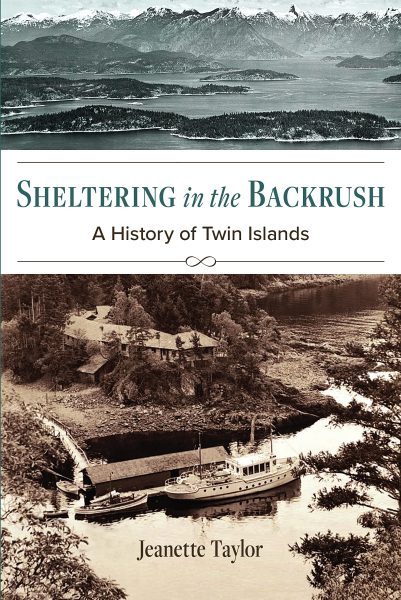
Sheltering in the Backrush: A History of Twin Islands
Review By Joy Davis
March 19, 2024
BC Studies no. 221 Spring 2024 | p. 261-263
Sheltering in the Backrush: A History of the Twin Islands is an engaging chronicle of life on two connected islands located at the southern entrance to Desolation Sound, 160 km north of Vancouver. Described as north and south Twin by locals, the Twin Islands are 281 hectares (694 acres) in size. They are distinctive in that they sit at the confluence of two tidal and climate zones. Tumultuous approaches by water and varied vegetation have shaped the lives of occupants of these islands over millennia.
As author Jeanette Taylor notes, “The beauty of the islands is captivating, but it’s her people who have taken root in my imagination…” (11). The strength of this book lies in the way in which Taylor threads peoples’ voices throughout her linear account of occupation and use. Taylor draws on extensive knowledge of the surrounding Discovery Islands, and her thorough research enables her to cite original as well as secondary sources. And Taylor makes effective use of photographs to illustrate activities and interpret relationships. Her citations and bibliography offer useful references for scholars.
Taylor’s account of the people who have dwelt on Twin begins with a description of seasonal occupation over millennia by Indigenous peoples. The islands, along with nearby Cortez and Hernando Islands, lie within Tla’amin territory that extends from Cortez to south of Powell River. Both archaeological research and ‘fragmentary oral histories’ (18) support her description of these islands as camps, harvesting sites and defensive refuges. She goes on to trace early European exploration and describes the devastating impact of smallpox on Indigenous people. The chapter ends with the sad statement that “Given these circumstances, it’s no surprise that places like Twin fell into disuse, leaving it open to be claimed as homestead land by immigrants” (26-27).
Subsequent chapters focus on settlers who established homes on Twin from 1889 to the present, eked out a living, and invited others to savour the beauty of the area. Not surprisingly, since records are more available for the settler period, Taylor is able to explore settlement in considerable detail.
From early homesteaders who led subsistence lives to later occupants who acquired Twin for recreational purposes, these islanders share the characteristics of many people along the coast who reside on islands not served by ferries. Taylor’s accounts demonstrate that such people tend to bring sophisticated backgrounds to island living, along with diverse skills, a high degree of agency, and capacity to innovate. They also demonstrate that to be successful on remote islands, tenacity and good health are crucial. Taylor tells engaging tales of personal resolve and conflict. Life on Twin was often challenging, made bearable by residents’ love of these “lonely, enchanted isles” (42).
The story of the acquisition of Twin by the influential Andrews family in 1936 and the construction of a sprawling lodge occupies several chapters. Taylor focuses on the Andrews’ business dealings, before focussing on challenges inherent in building a luxury resort in a remote location in war time. In the end, the Andrews’ twenty-year vision was never fully realized.
Their dream was picked up by subsequent owners as recreational land within reach of Vancouver was increasingly valued, and improved ferry and float plane services eased access. In the mid-1950s, Twin was owned by a succession of businessmen. Nonetheless, isolation inhibited frequent use. The property was sold in 1963 to His Royal Highness Margrave Berthold of Baden who was seeking a “secure investment and safe haven in the case of war” (112). Over the following decades, Twin Islands became an annual holiday retreat for the family. Taylor describes their time there in detail along with two memorable visits by Queen Elizabeth II.
This idyllic period came to an end in 1997 when the island was sold to a logger and developer. Taylor offers a thoughtful discussion of conflicting values, resulting protests, and innovative bargaining that ultimately led to the resale of Twin – but not before over three hectares had been cleared. Restrictive covenants were placed on island properties before Twin went back on the market. This fascinating story parallels environmental protests that have reshaped forest management in British Columbia.
Final chapters focus on the tenure of the Torrance family who purchased Twin as a holiday retreat in 2000. As with other owners, Taylor offers extensive background details and interviews to reveal the pleasures and challenges that owners and caretakers gain from island time. The depth of information that Taylor captures provides researchers with valuable information on the experience and motivations of the people who make islands home.
This history offers a wealth of carefully referenced detail that is rare in BC island history. Most island-focussed writing describes the lived experience of individuals or families, often in informal memoir styles. Jeannette Taylor is to be commended for her meticulous research combined with her ability to tell engaging stories. This book leaves me with two minor wishes. First, I would like to understand the significance of ‘backrush’ noted in the title, as the term isn’t addressed in opening chapters. And second, a detailed map of the Twin Islands would serve as valuable aid to better understand the Islands, their topography and surrounding waters, and how they are accessed and used. These are small points. Overall, Sheltering in the Backrush is a fascinating read and a valuable additional to the history of the region and province.
Publication Information
Taylor, Jeanette. Sheltering in the Backrush: A History of the Twin Islands. Madeira Park: Harbour Publishing. 2023. 160 pp. $24.95 paper.
